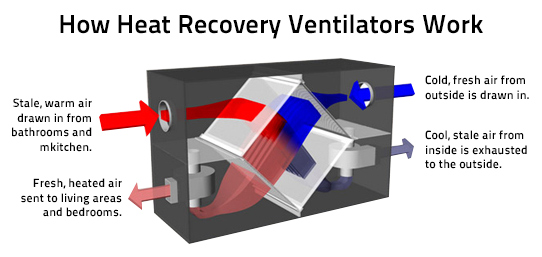The Growing Importance of HRV in Energy-Efficient Home Design
Wiki Article
Discovering the Perks of Heat Recovery Ventilation for Energy Effectiveness in Houses
Heat Recovery Ventilation (HRV) systems provide property owners a practical method to improving energy effectiveness. By recovering warm from outbound air, these systems can considerably decrease cooling and heating expenses. In addition, they provide a stable supply of fresh air, enhancing interior air high quality and convenience degrees. As home owners think about lasting choices, recognizing the subtleties of HRV systems comes to be progressively important. What elements should one examine prior to making such a financial investment?Understanding Heat Recovery Ventilation Solutions

Just How HRV Improves Indoor Air High Quality

Energy Cost Savings: The Economic Benefits of HRV
Optimizing power performance, heat recovery ventilation (HRV) systems use substantial monetary advantages for home owners. By recuperating and reusing warm from exhaust air, HRVs considerably lower cooling and heating expenses. This innovation can cause power savings of approximately 30%, depending upon climate and use patterns. House owners frequently see reduced utility costs shortly after setup, making HRVs an economically sensible investment gradually. In addition, lots of areas offer rewards or discounts for energy-efficient upgrades, further improving the economic appeal. As energy prices remain to rise, the cost-effectiveness of HRVs becomes progressively clear. Generally, the consolidation of HRV systems not just promotes power performance however also adds to long-lasting financial cost savings for families.The Ecological Influence of Heat Recovery Ventilation
A considerable environmental benefit of heat recovery ventilation (HRV) systems hinges on their capability to minimize overall power consumption. By recovering warmth from exhaust air and transferring it to inbound fresh air, HRV systems decrease the need for energy-intensive heating and cooling techniques. This decrease in power demand adds to decrease greenhouse gas discharges, as less fossil gas is required to preserve comfortable interior temperatures. In addition, HRV systems improve indoor air top quality by effectively exchanging stagnant air with fresh exterior air, reducing reliance on mechanical air conditioning systems that can harm the environment. On the whole, the implementation of HRV systems sustains sustainable living techniques and aligns with global efforts to battle climate modification by advertising energy effectiveness in household setups.
Picking the Right HRV System for Your Home
Exactly how can homeowners assure they choose the right heat recovery ventilation (HRV) system for their demands? They ought to examine their home's dimension and design, as these aspects affect air movement needs. Next off, reviewing the system's performance scores is crucial, as greater ratings show much better efficiency and energy savings. Homeowners ought to also consider installation and upkeep costs, contrasting various brand names and versions for worth. In addition, it's important to evaluate sound degrees, as some systems operate more quietly than others. Consulting with a/c experts can give customized recommendations based on certain home problems. Analyzing user evaluations and guarantees can aid in making a notified decision, making sure that the picked HRV system properly enhances indoor air high quality and power effectiveness.Frequently Asked Questions

Just how Usually Should I Clean or Preserve My HRV System?
The frequency of cleaning or maintaining a heat healing air flow (HRV) system commonly depends on use and ecological elements. Normally, it is a good idea to execute upkeep every six months to guarantee peak performance and air high quality.
Can HRV Solutions Assist Reduce Humidity Degrees Inside Your Home?
HRV systems can effectively lower interior moisture degrees by trading stagnant, humid air with fresh, drier air from outdoors. HRV Heat Recovery Ventilation. This process helps keep a balanced interior atmosphere, improving comfort and stopping moisture-related issues
What Is the Lifespan of a Common HRV System?
The life-span of a common heat recovery ventilation (HRV) system varies, normally lasting between 10 to 15 years. Routine maintenance can expand its performance and HRV Heat Recovery Ventilation operational life, making certain peak efficiency throughout its usage period.Are There Any Type Of Sound Worry About HRV Systems?
Sound worry about HRV systems can emerge, particularly from follower procedure. Nevertheless, many contemporary units are made to lessen audio levels, ensuring they operate quietly while keeping efficiency, which attends to potential disruptions in living environments.Can I Install an HRV System Myself, or Do I Required a Specialist?
The private contemplated whether to set up the heat recovery ventilation (HRV) system personally or work with a professional. Usually, while do it yourself installment is possible, proficiency warranties correct functionality and compliance with local building ordinance, improving system efficiency.Report this wiki page